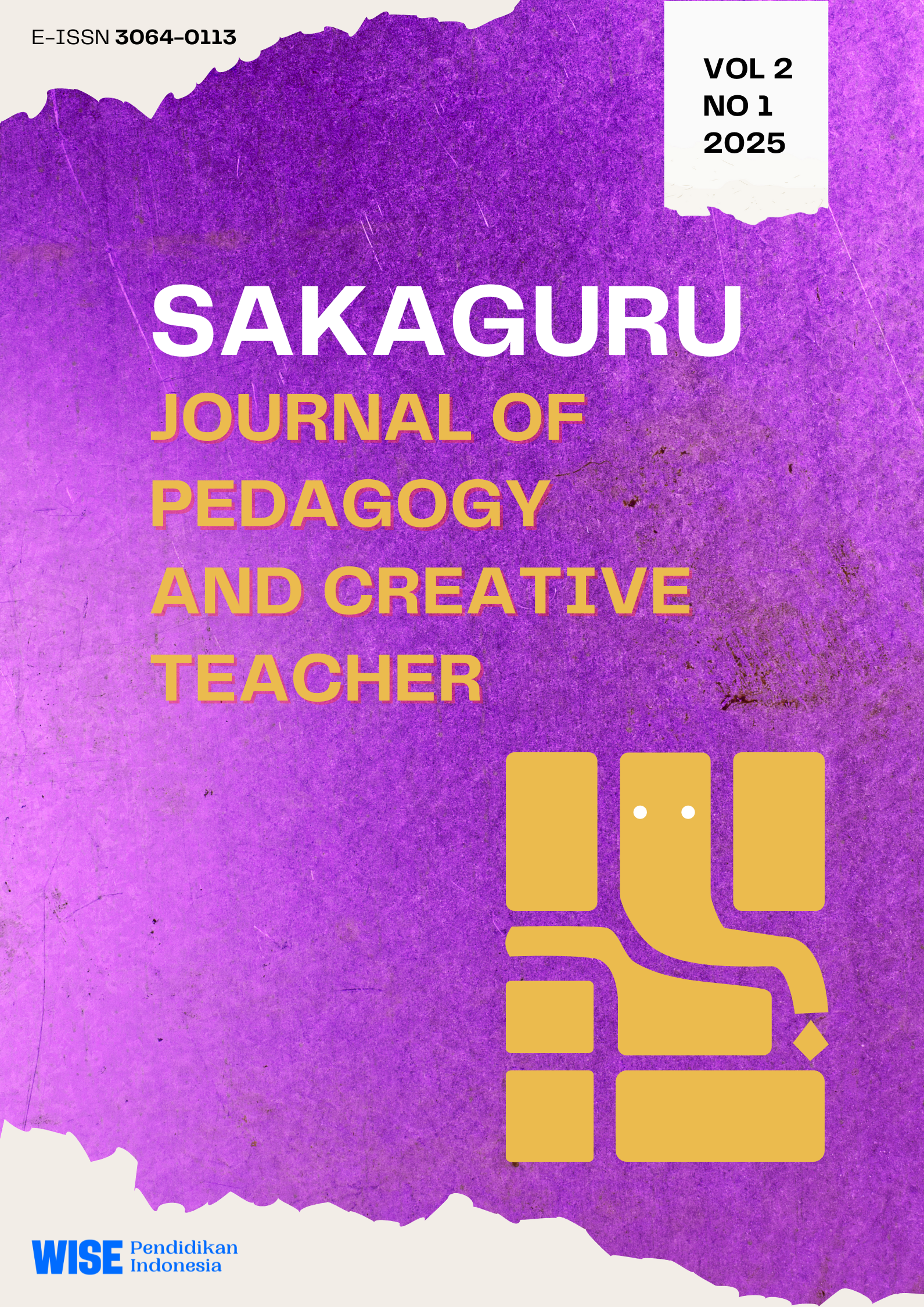Integration of Kaliurang Local Culture into Augmented Reality for Spatial Geometry Learning Media Development
DOI:
https://doi.org/10.70211/sakaguru.v2i1.203Keywords:
Augmented Reality (AR), Elementary School, Ethnomathematics, Spatial BuildingAbstract
A new challenge in 21st-century learning processes is the demand for technology integration without neglecting the richness of local culture. This research aims to develop Augmented Reality (AR) learning media integrated with the local culture of Kaliurang that is feasible and practical to use. This research approach uses a quantitative and qualitative approach, also known as a mixed method, with a research and development (R&D) design model 4-D consisting of four stages: define, design, develop, and disseminate. Data collection was conducted through interviews and questionnaires. The selection of subjects was carried out through random sampling with a population of sixth-grade students. The sample used in this study consisted of 25 sixth-grade students from SD Negeri Umbulharjo 2 over 2 months. The analysis of interview data was conducted descriptively, while the questionnaire data used descriptive statistical analysis. The analysis results found the need for the development of learning media, which was subsequently assessed for feasibility with an average score of 3.93 or 98.43%, categorized as "Very Feasible" by subject matter experts, and an average score of 4 or 100%, categorized as "Very Feasible" by media experts. The practicality test received an average score of 3.6 or 90%, classified as "Very Practical" by the students. The findings indicate that Augmented Reality (AR) integrated with the local culture of Kaliurang is well used as a learning medium for spatial geometry with the utilization of technology in the classroom at the elementary school level to support the understanding process of students. This research contributes to the development of innovative learning media integrated with the local culture of Kaliurang, which replicates the improvement of mathematics learning quality. Also, it provides a foundation for further research and practical application in the field of education.
References
E. Syahputra, “Pembelajaran abad 21 dan penerapannya di Indonesia,” Journal of Information System and Education Development, vol. 2, no. 4, pp. 10–13, 2024. doi: https://doi.org/10.62386/jised.v2i4.104. DOI: https://doi.org/10.62386/jised.v2i4.104
L. Darling-Hammond, M. E. Hyler, and M. Gardner, “Effective teacher professional development,” Learning policy institute. 2017. doi: https://eric.ed.gov/?id=ED606743. DOI: https://doi.org/10.54300/122.311
K. Anam, S. Mulasi, and S. Rohana, “Efektivitas Penggunaan Media Digital Dalam Proses belajar Mengajar,” Journal Of Primary Education. Genderang Asa : Journal Of Primary Education, vol. 2, no. 2, pp. 76–87. 2021. doi: https://journal.iainlhokseumawe.ac.id/index.php/genderangasa/article/view/161. DOI: https://doi.org/10.47766/ga.v2i2.161
Y. A. Sarumaha, A. P. Putra, and T. Hermawan, “Pengaruh penggunaan media pembelajaran berbasis digital terhadap pemahaman konsep matematika siswa kelas VIII SMP,” Apotema: Jurnal Program Studi Pendidikan Matematika, vol. 10, no. 1, pp. 21–30, 2021. doi: https://doi.org/10.31597/ja.v10i1.1043.
H. A. Spires, L. K. Hervey, G. Morris, and C. Stelpflug, “Teaching critical thinking skills using educational technology: A case study,” Journal of Research on Technology in Education, vol. 50, no. 2, pp. 163–182, 2018. doi: https://doi.org/10.1080/2331186X.2025.2477366. DOI: https://doi.org/10.1080/2331186X.2025.2477366
F. Marian, R. Handayani, and M. Yansyah, “Systematic Literature Review: Tren dan Tantangan dalam Penggunaan Media Pembelajaran Digital untuk Pendidikan Matematika,” Circle: Jurnal Pendidikan Matematika, vol. 5, no. 1, pp. 44–60, 2025. doi: https://doi.org/10.28918/circle.v5i1.10112.
P. I. Zulfa, M. Ni’mah, and N. F. Amalia, “Implementasi media pembelajaran berbasis teknologi it dalam mengatasi keterbatasan pendidikan di era 5.0 pada sekolah dasar,” EL Bidayah: Journal of Islamic Elementary Education, vol. 5, no. 1, pp. 1–15, 2023. doi: https://doi.org/10.33367/jiee.v5i1.3533. DOI: https://doi.org/10.33367/jiee.v5i1.3533
T. A. Silmi and A. Hamid, “Urgensi penggunaan media pembelajaran berbasis teknologi,” Inspiratif Pendidikan, vol. 12, no. 1, pp. 69–77, 2023. doi: https://doi.org/10.24252/ip.v12i1.37347. DOI: https://doi.org/10.24252/ip.v12i1.37347
N. G. Wahyudi and J. Jatun, “Integrasi Teknologi dalam Pendidikan: Tantangan dan Peluang Pembelajaran Digital di Sekolah Dasar,” Indonesian Research Journal on Education, vol. 4, no. 4, pp. 444–451, 2024. doi: https://doi.org/10.31004/irje.v4i4.1138.
L. S. Putri and H. Pujiastuti, “Analisis kesulitan siswa kelas v sekolah dasar dalam menyelesaikan soal cerita pada materi bangun ruang,” Terampil: Jurnal Pendidikan Dan Pembelajaran Dasar, vol. 8, no. 1, pp. 65–74, 2021. doi: https://doi.org/10.24042/terampil.v8i1.9200. DOI: https://doi.org/10.24042/terampil.v8i1.9200
G. dkk Nursyamsiah, “Analisis Kesulitan Siswa SMP Kelas VIII dalam Menyelesaikan Soal Materi Bangun Ruang Sisi Datar,” Maju, vol. 7, no. 1, pp. 98–102, 2020.
E. Gun and B. Atasoy, “The effects of augmented reality on elementary school students’ spatial ability and academic achievement,” EGITIM VE BILIM-EDUCATION AND SCIENCE, vol. 42, no. 191, 2017. doi: http://doi.org/10.15390/eb.2017.7140. DOI: https://doi.org/10.15390/EB.2017.7140
J. Piaget, “Piaget’s theory,” in Piaget and his school: A reader in developmental psychology içinde, B. Inhelder and H. H. C. C. Zwingmann, Eds., New York: Springer-Verlag, pp. 11–23, 1976. DOI: https://doi.org/10.1007/978-3-642-46323-5_2
M. J. Koehler and P. Mishra, “Teachers learning technology by design,” J Comput High Educ, vol. 31, no. 1, pp. 1–22, 2019.
A. Wildan, S. Suherman, and I. Rusdiyani, “Pengembangan Media GAULL (Game Edukasi Wordwall) pada Materi Bangun Ruang untuk Siswa Sekolah Dasar,” Jurnal Cendekia: Jurnal Pendidikan Matematika, vol. 7, no. 2, pp. 1623–1634, 2023. DOI: https://doi.org/10.31004/cendekia.v7i2.2357
W. R. A. Wati, Analisis media pembelajaran interaktif berbasis aplikasi Geogebra dalam pembelajaran bangun ruang di sekolah dasar, vol. 2, no. 1, 2022. Prosiding: Konferensi Nasional Matematika dan IPA Universitas PGRI Banyuwangi. DOI: https://doi.org/10.30651/didaktis.v22i2.12430
N. Abubakar, W. T. Pulukadang, and A. Marshanawiah, “Pengembangan Media Pembelajaran Bangun Ruang Berbasis Adobe Flash Pada Siswa Sekolah Dasar Pulubala,” Jurnal Studi Guru dan Pembelajaran, vol. 7, no. 2, pp. 673–683, 2024. DOI: https://doi.org/10.30605/jsgp.7.2.2024.4151
S. Hidayah, E. Mailani, R. Sitohang, N. Nurmayani, and A. Gandamana, “Pengembangan Media Pembelajaran Matematika Materi Luas Bangun Ruang Sisi Datar Berbasis Augmented Reality berbantuan Unity 3D Untuk Meningkatkan Hasil Belajar Siswa Kelas V Sekolah Dasar,” Innovative: Journal Of Social Science Research, vol. 4, no. 5, pp. 95–111, 2024.
G. C. Rorimpandey and C. N. Kalalo, “Aplikasi Belajar Matematika Dasar berbasis Augmented Reality,” Seminar Nasional Teknologi Informasi dan Komunikasi (SEMNASTIK, vol. 1, no. 1, pp. 796–804, 2018.
T. Lowrie, T. Logan, and A. Ramful, “Spatial Reasoning Influences Students’ Performance on Mathematics Tasks,” in Opening up mathematics education research (Proceedings of th e 39 annual conference of the Mathematics Education Research Group of Australasia, Adelaide: MERGA Th, pp. 407–414, 2016. doi: https://eric.ed.gov/?id=ED572328.
C. Papakostas, C. Troussas, A. Krouska, and C. Sgouropoulou, “Exploration of augmented reality in spatial abilities training: a systematic literature review for the last decade,” Informatics in Education, vol. 20, no. 1, pp. 107–130, , 2017. doi: https://www.ceeol.com/search/article-detail?id=936705. DOI: https://doi.org/10.15388/infedu.2021.06
Z. Hawes, J. Moss, B. Caswell, S. Naqvi, and S. MacKinnon, “Enhancing children’s spatial and numerical skills through a dynamic spatial approach to early geometry instruction: Effects of a 32- week intervention,” Cogn Instr, vol. 35, no. 3, pp. 236–264, 2017 doi: 10.1080/07370008.2017.1323902. DOI: https://doi.org/10.1080/07370008.2017.1323902
U. Lu’luilmaknun and D. Novitasari, “Pemanfaatan Teknologi Pada Media Pembelajaran Berbasis Etnomatematika,” Mandalika Mathematics and Educations Journal, vol. 6, no. 2, pp. 879–884, 2024. doi: https://doi.org/10.29303/jm.v6i2.8313. DOI: https://doi.org/10.29303/jm.v6i2.8313
D. Amelia, F. J. Rahmadani, M. N. R. Septiyani, M. A. Abdurrafi, and N. Maulidah, “Peran Media Pembelajaran Etnomatematika dalam Meningkatkan Minat Belajar Matematika Siswa SD: Tinjauan Literatur,” Jurnal Ilmiah Profesi Pendidikan, vol. 10, no. 1, pp. 875–883, 2025. doi: https://doi.org/10.29303/jipp.v10i1.2953. DOI: https://doi.org/10.29303/jipp.v10i1.2953
M. Rosa and D. C. Orey, “An Ethnomathematical Perspective of STEM Education in a Glocalized World,” Bolema: Boletim de Educação Matemática, vol. 35, no. 70, pp. 840–876, 2021. doi: 10.1590/1980-4415v35n70a14. DOI: https://doi.org/10.1590/1980-4415v35n70a14
N. W. Nugraha and N. Novaliyosi, “Media pembelajaran berbasis etnomatematika: systematic literature review,” Jurnal Lebesgue: Jurnal Ilmiah Pendidikan Matematika, Matematika Dan Statistika, vol. 4, no. 1, pp. 477–490, 2023. doi: https://doi.org/10.46306/lb.v4i1.286. DOI: https://doi.org/10.46306/lb.v4i1.286
J. W. Creswell, Research Design: Qualitative, Quantitative, and Mixed Method Approaches. Thousand Oaks, CA: SAGE. 2017.
S. Arikunto, Prosedur penelitian: Suatu pendekatan praktik. Jakarta: Rineka Cipta. 2014
S. Arikunto, Prosedur Penelitian Suatu Pendekatan Praktis: PT. Rineka Cipta. 2017.
R. Rahayu, S. Iskandar, and Y. Abidin, “Inovasi Pembelajaran Abad 21 dan Penerapannya di Indonesia,” Jurnal Basicedu, vol. 6, no. 2, pp. 2099–2104, 2022 doi: 10.31004/basicedu.v6i2.2082. DOI: https://doi.org/10.31004/basicedu.v6i2.2082
E. Kosasih, Pengembangan Bahan Ajar. Jakarta: Bumi Aksara. [Online]. 2021. Available: https://books.google.co.id/books?hl=id&lr=&id=UZ9OEAAAQBAJ&oi=fnd&pg=PP1&dq=Pengembangan+Bahan+Ajar&ots=Wq3GPtXYgu&sig=4_sM6yFuR-FQ5xaYPQR7bkQPGFk&redir_esc=y#v=onepage&q=Pengembangan%20Bahan%20Ajar&f=false
A. Rahmadani, F. K. S. Harahap, N. Ulkaira, Y. Azhari, and S. Hasibuan, “Efektivitas Penggunaan Strategi Pembelajaran Dalam Meningkatkan Hasil Belajar Siswa Di SD Negeri 060822 Medan,” Pendekar: Jurnal Pendidikan Berkarakter, vol. 2, no. 1, pp. 54–71, 2024. doi: 10.51903/pendekar.v2i1.566.
S. T. Ghafara, W. Simatupang, A. Ambiyar, M. Muskhir, and D. Irfan, “Pengembangan Media Pembelajaran Berbasis Android–Pembelajaran Inovatif untuk Meningkatkan Kompetensi Siswa Smk,” ZONAsi: Jurnal Sistem Informasi, vol. 4, pp. 1–17, 2022. doi: 10.31849/zn.v4i.12450. DOI: https://doi.org/10.31849/zn.v4i.12450
S. N. Ayunda, L. Lufri, Z. Zulyusri, and S. Fajrina, “Pengembangan E-Booklet Bernuansa Emotional Spiritual Quotient (ESQ) Tentang Materi Perubahan Lingkungan untuk Peserta Didik Kelas X Fase E SMA/MA,” Jurnal Inovasi Pembelajaran Biologi, vol. 5, no. 2, pp. 90–106, 2024. doi: 10.26740/jipb.v5n2.p90-106. DOI: https://doi.org/10.26740/jipb.v5n2.p90-106
R. S. Untari, F. N. Hasanah, M. D. K. Wardana, and M. I. Jazuli, “Pengembangan augmented reality (AR) berbasis Android pada pembelajaran pemodelan bangun ruang 3D”. 2022. doi: https://doi.org/10.17977/jptpp.v7i5.15238. DOI: https://doi.org/10.17977/jptpp.v7i5.15238
F. Rozi, R. R. Kurniawan, and F. Sukmana, “Pengembangan media pembelajaran pengenalan bangun ruang berbasis augmented reality pada mata pelajaran matematika,” JIPI (Jurnal Ilmiah Penelitian dan Pembelajaran Informatika, vol. 6, no. 2, pp. 436–447, 2021. doi: https://doi.org/10.29100/jipi.v6i2.2180. DOI: https://doi.org/10.29100/jipi.v6i2.2180
K. Rachman, C. Pangestika, S. R. Vesya, and A. P. Arbiyanti, “Development of Android-based applications integrated with Tari Piring culture as ethnomathematics learning media for elementary school students,” Union: Jurnal Ilmiah Pendidikan Matematika, vol. 13, no. 1, pp. 200–212, 2025. doi: https://doi.org/10.30738/union.v13i1.19217. DOI: https://doi.org/10.30738/union.v13i1.19217
Downloads
Published
Issue
Section
License
Copyright (c) 2025 Kufita Rachman, Ilham Rasyid, Ade Puteri Arbiyanti, Siti Raihani Vesya

This work is licensed under a Creative Commons Attribution 4.0 International License.








